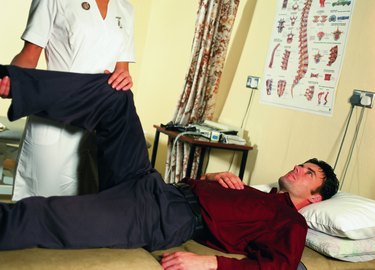
Imagine your hip joint as a cup that fits over a ball on a stick. The ball can rotate around the cup to facilitate movement -- in the case of your hip joint, movements like walking and kicking. If you experience hip dysplasia, your hip socket -- the cup -- does not completely cover the ball-like attachment of your leg. Hip dysplasia places added pressure on your hip joint and can result in pain and arthritis symptoms. To minimize these symptoms, you can perform exercises to restore range of motion.
Hip Abduction
Video of the Day
Hip abduction exercises involve lifting the leg away from the body. This strengthens the muscles that act on the hip to provide greater stability and strength. Wrap a resistance band around your ankles and point your right foot to the side. Slowly lift your leg to your side as high as you are able without pain; do not push to the point of muscle strain. Hold for three to five seconds, then lower the leg. Repeat 10 times, then lower to rest for 30 seconds. Switch to your opposite leg and repeat the exercise.
Video of the Day
Lying Hip Stretch
Lie on your back with your legs extended. Gently pull your knee toward your torso, wrapping your arms around your knee for support. Try to keep the left leg as straight as possible. Hold this stretch for 15 to 30 seconds, then release the knee. Repeat by pulling your left leg in toward your chest. Complete the exercise by repeating three times on each leg.
Side Leg Lifts
This exercise involves rotating the leg and lifting it to work the inner hip muscles. Turn your toes out, so that your feet are facing away from each other. Slowly lift your left leg upward, bending at the knee. Do not lift the leg higher than hip height. Hold at the highest point you can comfortably stretch for three to five seconds, then lower the leg to the ground. Repeat eight to 10 times, then perform on the opposite leg.
Exercises to Avoid
Although cardiovascular exercises like swimming and walking can help you maintain your weight and challenge your heart and lungs, other exercises may be too hard on those with hip dysplasia. These include running and impact sports such as football. Other exercises, such as rowing, tennis or riding a bicycle, also should be performed in moderation because they place some degree of strain on the hip joints. Refrain from using these exercises as your primary means of exercise.